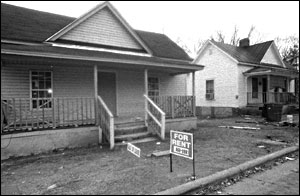| |

Homes like these were once part of a solid working class community, anchored by factory jobs and black-owned businesses. Photo: Steve Schapiro / American RadioWorks |
In poor black and Latino neighborhoods across the country, disproportionate numbers of households have a parent—usually a father—away in prison. Black men are eight times more likely to go to prison than whites, and Latinos six times more likely than whites. The imprisonment gap has deepened the economic gaps among racial and ethnic groups. The stigma and damaged earning power that come with a prison record have been disproportionately stamped on men and women of color.
A few years ago, economists celebrated that job growth in the 1990s had put more people to work among all groups of Americans. The rising economy was genuinely lifting all boats. Even black men who'd dropped out of high school were finding jobs in record numbers, the experts said. But Bruce Western, a sociologist at Princeton, analyzed the numbers more closely. The sunny employment figures assumed that those who left the ranks of the unemployed did so by getting jobs.
"But once you take into account that a large number of these men are in prison or jail"—not in the workforce—"there's actually no improvement in the employment rate over this period," Western explains.
In other words: for young black men with little education, the prison boom wiped out the economic boom.
Experts like Western talk about incarceration as a form of churning—removing people from the neighborhood, then sending them back as a bigger drag on the community than they were before. Multiply that effect hundreds of times in a neighborhood and, some researchers say, the effect can be the reverse of what's intended.
In the late 1990s, sociologist Dina Rose and her colleague Todd Clear, then at Florida State University, looked carefully at crime statistics in Tallahassee. They found that in the neighborhoods with the highest incarceration rates in a given year, crime went up faster the following year than in other comparable neighborhoods with lower incarceration rates. Controlling for other factors affecting crime, they and reached a provocative conclusion:
"There was a tipping point at which increasing the number of people in prison really increased crime in those areas," says Rose. "That's not to say that we shouldn't be incarcerating anyone, because at low and moderate levels, [imprisonment] does [reduce crime], and there are clearly people in these neighborhoods who need to be removed. But it does mean we need to think about our use of incarceration very carefully and try to think about the ways in which incarceration as a process of removing and returning people can destabilize communities in general."
Steve Hopkins, the ex-con and community activist, agrees that some criminals need to be arrested and locked up. But ask him what he would do to make things better in east Durham, and stepped-up crime fighting doesn't make his wish list.
"I would make sure that everybody from the age of eighteen and up had a safe, decent place to stay," Hopkins says. Other priorities: a stronger education system to help young people follow their dreams, and better jobs for them to aspire to.
"But," says Hopkins, "I see now a big disconnect. People would rather lock you up and throw the keys away than to help you discover who you are and to help you become who you can be. And that's a waste of people. We can't afford to just throw people away like that, like yesterday's shoes."
Return to Hard Time index

